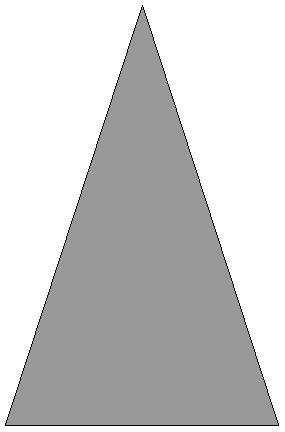Constructions for the Golden Ratio
Decagons
 The smallest angle in the "pentagram triangle" was 36° so we can pack
exactly ten of
these together round a single point and make a decagon as shown here.
The smallest angle in the "pentagram triangle" was 36° so we can pack
exactly ten of
these together round a single point and make a decagon as shown here.
1·61803 39887 49894 84820
45868 34365 63811 77203 09179 80576 ..More..
![]()
 Here is a decagon - a 10-sided regular polygon with all its angles
equal and all its
sides the same length - which has been divided into 10 triangles.
Here is a decagon - a 10-sided regular polygon with all its angles
equal and all its
sides the same length - which has been divided into 10 triangles.
Because of its symmetry,
all the triangles have two sides that are the same length and so
the two other angles in each triangle
are also equal.
In each triangle, what is the size of the angle at the
centre of the decagon?
We now know enough to identify the triangle since we know one angle
and that
the two sides surrounding it are equal.
Which triangle on this page is it?
From what we have already found out about this triangle earlier, we can now say that
The radius of a circle through the points of a decagon is Phi times as long as the side of the decagon.
This follows directly from Euclid's Elements Book 13, Proposition 9.
1·61803 39887 49894 84820
45868 34365 63811 77203 09179 80576 ..More..
![]()
Penrose tilings

Recently, Prof Roger Penrose has come up with some tilings that exhibit five-fold symmetry yet which
do not
repeat themselves for which the technical term is aperiodic or quasiperiodic. When they appear in nature in crystals, they
are
called quasicrystals.
They were thought to be impossible until fairly recently.
There is a lot in common between Penrose's tilings and the Fibonacci
numbers.
The picture above is made up of two shapes of rhombus or rhombs - that is, "pushed over squares"
where each shape has all sides of the same length. The two rhombs are
made
from gluing two of the flat pentagon triangles together along their long
sides
and the other from gluing two
of the sharp pentagon triangles together along their short sides.

Dissecting the Sharp and Flat Triangles:
Here the sharp triangle is dissected into two smaller sharp triangles and one flat triangle, the flat triangle into one smaller flat and one sharp triangle. At each stage all the triangles are dissected according to this pattern.
Repeating gives rise to one version of a Penrose Tiling.

Note that the top "flat" diagram shows the sharp and flat triangles have
the same height
and that their bases are in the ration Phi:1 (or 1: Phi-1 which is
1:phi):
if the shortest sharp triangle's side = the longest flat triangle's side
Since the Kite and Dart are made of two identical triangles, then
The diagram on the right shows the relationship between the kite and
dart
and a pentagon and pentagram.
You can make similar tiling pictures with
Quasitiler
3.0,
a web-based tool and its link mentions more references to
Penrose tilings.
A floor has been tiled with Penrose Rhombs at Wadham College at Oxford
University.
Here are some interesting links to the Penrose tilings at other sites.
![]() Here are some
ready-to-photocopy Penrose tiles for you to photocopy and
cut-out and
experiment with making tiling patterns.
Here are some
ready-to-photocopy Penrose tiles for you to photocopy and
cut-out and
experiment with making tiling patterns.
![]() The Geometry Junkyard has a
great
page of Penrose links
The Geometry Junkyard has a
great
page of Penrose links
![]() Ivars Peterson's ScienceNewsOnline
has
an
interesting page about quasicrystals showing
how Penrose tilings are found in nature.
Ivars Peterson's ScienceNewsOnline
has
an
interesting page about quasicrystals showing
how Penrose tilings are found in nature.
![]() Pentaplex sell puzzle tiles based on
a Penrose tiling.
Pentaplex sell puzzle tiles based on
a Penrose tiling.
![]() Eric Weisstein's Penrose Tilings entry in his World of Mathematics online encyclopaedia.
Eric Weisstein's Penrose Tilings entry in his World of Mathematics online encyclopaedia.
![]() Penrose
Tiles to Trapdoor Ciphers,
1997,
chapters 1 and 2 are on Penrose Tilings and, as with all of
Martin Gardner's mathematical writings
they are a joy to read and accessible to everyone.
Penrose
Tiles to Trapdoor Ciphers,
1997,
chapters 1 and 2 are on Penrose Tilings and, as with all of
Martin Gardner's mathematical writings
they are a joy to read and accessible to everyone.
![]() A Near Golden Cuboid by Graham Hoare in Mathematics Today Vol 41, April 2005, page 53
gives the relationship between the pentagon/pentagram and
Penrose's kite and dart.
A Near Golden Cuboid by Graham Hoare in Mathematics Today Vol 41, April 2005, page 53
gives the relationship between the pentagon/pentagram and
Penrose's kite and dart.